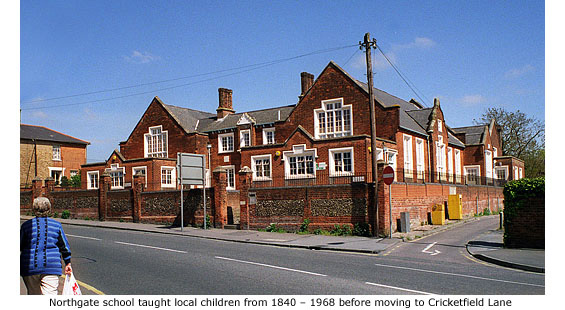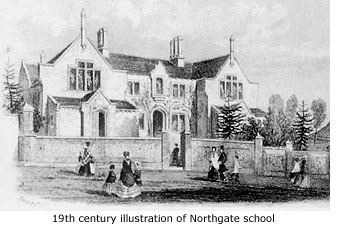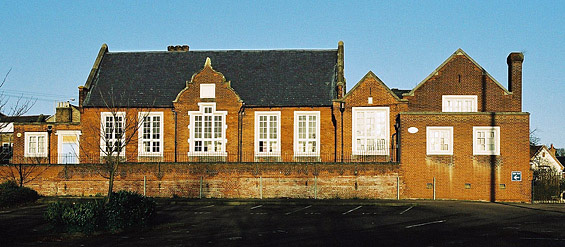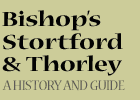|
The Rising Sun
After serving the public for 150 years, the Rising Sun closed its doors for the last time in October 2001. Demolition took place in June 2003 and the present car showroom was built on the site shortly after. Whether or not the pub’s title was the same when it first opened for trade in 1851 isn’t known, but we do know the occupant at that time was a bricklayer named John Eaden. The pub was bought from Flinn's Brewery in 1937, but not granted a full licence until 1951.
The original house, with stables and a well at the rear, was thought to be much older than it appeared and in its time had two separate extensions added to the frontage, covering the original garden. MORE PICTURES
|
|

With segregated ‘Boys’ and ‘Girls’ signs etched into the stonework of their respective classrooms, this archetypal 19th century schoolhouse was one of Bishop’s Stortford’s first primary schools.
It was built as a direct result of the Evangelical movement, which in the 18th century had renewed public interest in the reading of the Bible. Its mission was somewhat impeded, though, by the fact that almost half of the country’s population could neither read nor write.
However, coupled with a national development in Sunday schools, two new societies were formed to create day schools – their purpose being to bring the rudiments of education to children of the poorer classes.
The first of these was the British Society, inspired by Joseph Lancaster and created by Nonconformists – people who did not believe in sectarian education but who enforced Bible reading. The other was The National Society instigated by Dr Bell – an Anglican organisation whose intention was to promote the principles of the Church of England.
Locally, on 28 February 1839, a group of people met in the George Inn at North Street to discuss the building of a new school at Northgate End. It was to be financed by the British Society and the Congregational Church in Water Lane, and also by public subscription - the most notable donation received being £20 from the prime minister of the day, Lord Melbourne.
Progress was swift. Twenty-one trustees were elected, a plot of land called Lime Kiln Meadow was purchased adjacent to the cattle market, and within a year the schoolhouse of a ‘British School’ was almost complete. The boys section opened in January 1840 followed by the girls section in March, each with its own Headmaster and Headmistress empowered ‘to admit children of any persons of the labouring classes on terms provided, while children of tradesmen paid 6d (2 1/2p) a week and cost of stationery.'
With nothing more than 18 Bibles, a map of the world and plenty of determination, both Heads, Mr Skinner and Miss Unwin, set about the task of educating local children. Their success was reflected in a school inspector’s report of 1846, praising the school’s academic qualities. Not everything ran smoothly though. By 1874 the school building was in urgent need of repair and debts had accrued, but after a short period of closure and the appointment of new trustees the matter was resolved.
 When education became the responsibility of local councils in 1902, the word ‘British’ was deleted from the school’s title and it was renamed Northgate. High up, etched into stonework at the centre of the building, the word ‘British’ is still discernible above the word ‘School’.
When education became the responsibility of local councils in 1902, the word ‘British’ was deleted from the school’s title and it was renamed Northgate. High up, etched into stonework at the centre of the building, the word ‘British’ is still discernible above the word ‘School’.
By 1909 the school’s intake of 340 children had far exceeded the recognised accommodation limit of 245, the problem not helped by staff shortage and a lack of teaching space. Pupil-teacher ratio, illustrated in school records of that time, shows the Senior Assistant had to teach and control 73 children in two sections. As a result of this unacceptable situation, small alterations and improvements were made, but further improvements planned for 1914 were put on hold by the outbreak of World War I.
In 1924/25 the County Council renovated and improved facilities, and a field was purchased behind the school for games and gardening. Naturally, the council didn’t consider a lawnmower was necessary to cut the grass of the field, so the Headmaster used his own. Of paramount importance, though, was education and the school maintained a first class academic and social record.
|
|
At the start of the Second World War, in 1939, the school prepared itself to take evacuee children from London and coped well with the influx until 1944. Faced with 300 pupils to accommodate, the Mission Hall in Barrells Down Road was secured for use as an additional classroom.
In 1947 many of the changes contained in the 1944 Education Act were finally implemented and Northgate became a JMI (Junior Mixed Infants) school catering for 5-11 year olds. Older pupils were transferred to the town’s first secondary modern school – a conversion of wartime huts originally built by the Americans as a rest centre on land currently used as Causeway car park (See Guide 8).
The new found social freedom of the 1960s, together with more liberal views on education were, at first, slow to catch on at Northgate school. In 1965, pre-1920 furniture was installed in classrooms, slates and chalk were used in infant reception classes, and corporal punishment was still the order of the day for misdemeanours. Even parents were not allowed to enter the school gate without a prior appointment.
But changes for the good of the pupils did eventually happen, the best of these being the building of a new Northgate school at Cricketfield Lane. Started in 1966 it was meant to be built in three phases over a period of six months, but after the contractor repeatedly missed deadlines it wasn’t until May 1968 that the last pupils moved out of Northgate.
They left behind a Victorian building that was, by now, totally unsuitable for 20th century use as a school, but one that had given previous generations a sound education and many happy memories. The new school became every bit as successful as its predecessor and in 1999 was enlarged and modernised to cater for Bishop’s Stortford’s ever-growing population. After 1968 the old school building at Northgate End was briefly used as a child nursery but is currently used as additional learning classes by Hertford Regional College.
David Bowes
The school's most popular and longest serving Headmaster in recent years was David Bowes (1926-2004). Raised in Hatfield and a lifelong Hertfordshire resident, he became Head in 1965 and saw the school through its transistional period before retiring in 1988. He seemingly remembered every child who was ever taught at Northgate during his time there, often stopping them in the street long after they had left the school to ask after their welfare. David Bowes continued his association with Northgate after he retired, and in 1999 received an East Herts District Council community award for his 'outstanding contribution' to the town. In 1989 he wrote a brief history of the school to commemorate its 150th anniversary, and it is from that history that most of the above text is drawn. MORE PICTURES
|






 When education became the responsibility of local councils in 1902, the word ‘British’ was deleted from the school’s title and it was renamed Northgate. High up, etched into stonework at the centre of the building, the word ‘British’ is still discernible above the word ‘School’.
When education became the responsibility of local councils in 1902, the word ‘British’ was deleted from the school’s title and it was renamed Northgate. High up, etched into stonework at the centre of the building, the word ‘British’ is still discernible above the word ‘School’.